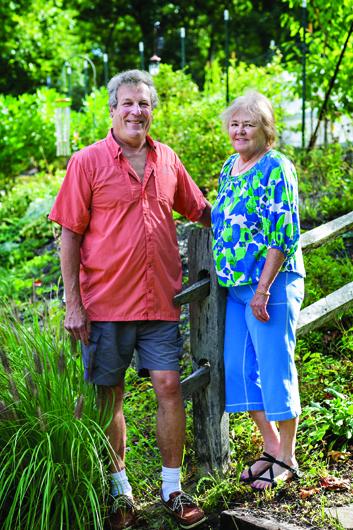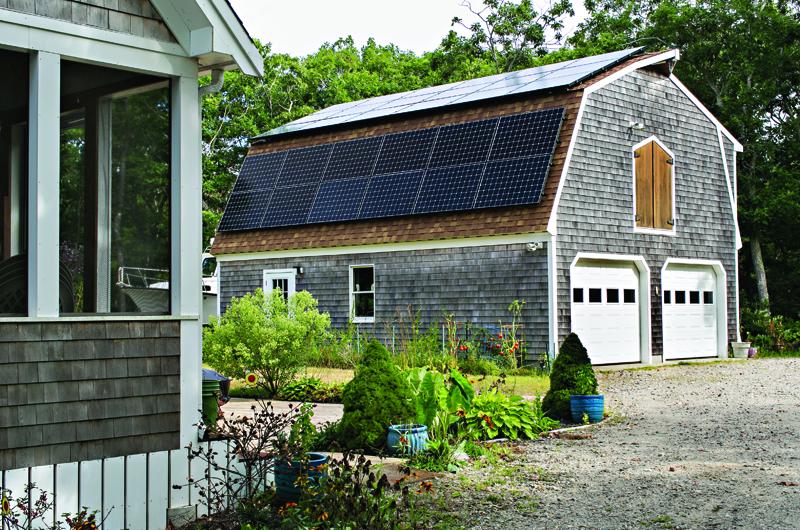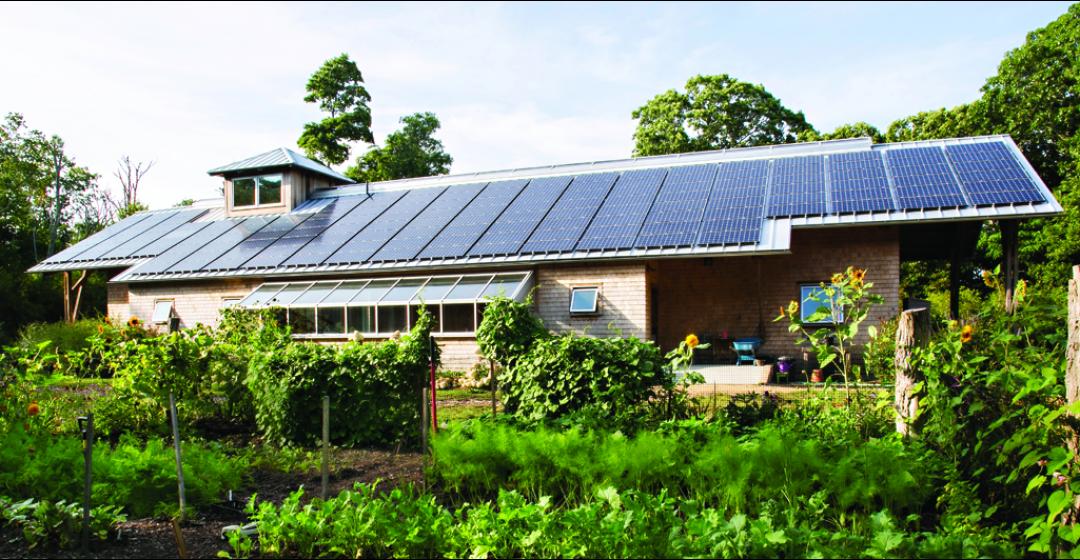On a rainy day in a wooded neighborhood of Oak Bluffs, Llewellyn Rogers can make $1.40 lounging in his sun room and admiring his new solar array. When the sun is beating down on his 832-square-foot garage, he can make north of $12 a day.
Over time, the savings add up. In less than four months, the solar array saved Rogers more than $1,000 in electricity costs. It also avoided the production of 8,079 pounds of carbon dioxide emissions, or roughly the equivalent of an estimated 79 trees or 270 barrels of oil, according to the online program that West Tisbury design and build firm South Mountain Company set up to monitor their solar projects.
For the first time in his sixty-eight years, Rogers says he’s excited when a bill arrives in the mail. “Now I’m waiting for that electric bill,” he said.
Homeowners go solar on the Vineyard to save the planet and to save money. For Rogers, the priority was reducing his electric bill. He and his wife Beverly retired to the Island on fixed incomes in 2009. “I like to save a tree, but it’s like, save a buck, then save a tree,” he said.

The solar array at the Rogers’ house contains thirty modules, which are groupings of photovoltaic cells arranged in a lattice that convert sunlight into electric current. An apparatus called an inverter, which is installed between the gardening supplies in the garage, takes the direct current created by the modules and converts it into the alternating current suitable for home appliances. According to the Massachusetts Clean Energy Center, solar systems commonly pay for themselves within five to eight years. They also generally carry a warrantee of twenty years, though the panels can last much longer. And with the solar renewable energy certificates, or SRECs (tradeable commodities that solar producers can sell back to the utility company), Rogers calculated that the system at his house will pay for itself in about five and a half years.
“You can’t get that on any other investment,” he said.
In recent years, the cost of solar installation has decreased considerably. What’s more, state and federal tax incentives and rebates make the switch even more economical. Homeowners are eligible for federal tax credits up to thirty percent of the cost of a solar system, as well as rebates from the state, and the solar renewable energy certificates.
How long those incentives will last, however, is a political question. Policy matters a lot when it comes to solar issues, said Rob Meyers, the energy services general manager at South Mountain Company. The federal tax credit expires in 2016, and its renewal is uncertain. The future of solar is also unpredictable at the state level, where politics largely determine the prevalence of solar incentives. The current state rebate program expires in December 2014.
“It will only get worse,” said Bill Bennett, an electrician who has been installing solar systems since 1992 and is the managing partner at Solar Invictus in Vineyard Haven. “Now is the time to do it.”

It’s unclear at the moment how the addition of solar panels will affect property values. Some think solar panels will eventually increase the value of a property, but according to Meyers the real estate appraisal industry is just beginning to include them in their assessments of property value. “It’s not a big driver for a lot of folks,” he said.
For his part, Rogers doesn’t think the solar array adds much value to his home, as many people seem to find the panels unattractive. But, he said, the silent panels are far more palatable than a wind turbine. “The buyer would have to be knowledgeable for it to be an asset,” his wife Beverly added.
Rogers has taken an unusual interest in the system, reading up on the technology and monitoring its performance closely. As a retired electrical-mechanical technician for Raytheon, he also has a solid understanding of electricity. For others, the terminology and economics associated with solar electricity can be intimidating. As a result, solar contractors on the Island say they take time to educate and empower their clients, giving them tools to monitor the performance of the system.
If a South Mountain client notices a discrepancy between the expected and actual output, for instance, Meyers can compare it with the more than one hundred solar sites the company monitors online. “We can say, all of our systems are seeing that; it’s most likely weather related,” he said. “You have the ability to see systems across the Island, so you can actually compare for folks.”
Liz Taft, a landscape painter, says she gets a thrill out of watching the numbers go up on her inverter as the panels soak up the sun above. “It makes so much sense,” said her wife Nancy Gilfoy, an acupuncturist. “Instead of thinking of a roof as just a roof, use it as a generator of electricity.”
The rooftop installation at their home in Vineyard Haven has twenty-four modules, and it produces a substantial portion of the household electrical use. Unlike the Rogers, Taft and Gilfoy are leasing their solar system from the manufacturer, SunPower, though they may consider purchasing it if they ever sell their home. Since installing it two years ago, their electric bills have gone down by $100 per month at least.
“The day we turned them on, we were so happy,” said Gilfoy. “It was a big transformation from being energy consumers to generating electricity. It flips things in a big way.”
“It was the most exciting bill we’ve ever paid,” echoed Taft.
Though they are pleased to save money in electric costs over the long-term, the true motivation was environmental. “We live here because we love the earth, so let’s take care of it as best we can,” Taft said.
Kate Warner, a solar pioneer on the Vineyard, feels the same way. An architect working on the Vineyard since 1987, Warner installed her first panels at her home in 1998. Today, she has two arrays that will produce as much as 5,500 kilowatt-hours this year – more electricity than she needs. She sends the excess back into the NSTAR grid through net metering. She’s currently running a negative tab with the utility.
While encouraging prospective clients to include solar in their projects, Warner lived the solar lifestyle at home, where she minimized her own electricity use and purchased energy-efficient appliances. Though she is no longer designing solar systems, she continues to spread the gospel of solar.
“The reason I promoted solar electric systems in the first place was for a benefit to the planet,” she said. “Climate change is occurring and electrical use is one of the ways we all contribute to it.”
She says owners of second homes also have a unique opportunity to give back when they’re not on the Island. “It’s great to generate power for the Island whether you are here or not,” she said. “That way, you get the maximum benefit from your system and you’re feeding the grid at the same time.”
Another reason for the boom in solar on the Island is that the growing efficiency of the technology and the solar-friendly policies of Massachusetts mean most roofs on the Vineyard are suitable for an effective array. The exceptions are those that are both steep and north-facing, or are excessively shaded. Solar arrays also can be installed on the ground, where they can be oriented to optimize their solar exposure.
The regulatory environment is particularly crucial. “When you fly over the Commonwealth, you see solar everywhere,” said Meyers. “But when you fly over Florida, the Sunshine State, you see virtually no solar.”
Most solar systems on the Vineyard are tied into the NSTAR grid. This allows them to draw power when their solar arrays are not producing enough to power the house, and to earn credits toward future electric bills when they are producing a surplus. A few houses, however, are wired to be entirely self-sufficient and are tied instead to a generator, which kicks in when needed.
Next fall, if all goes according to plan, Bennett will be able to offer new clients a sort of hybrid ability to stay wired not only to the NSTAR grid, but also to a backup battery system that will ensure power even when NSTAR goes offline in a severe weather event. The technology, which uses the latest lithium ion batteries, is already available in Europe.
“The important thing is for people to reach out to an installer regardless of whether they think going in that it’s affordable,” Bennett said. Proposals are generally performed at no cost to the prospective client, and involve several financing options.
“Most people think they can’t afford it and in reality, right now they can because of the loans available and the rebates,” Warner echoed.
For as long as those incentives and loans last, that is.
The Massachusetts Clean Energy Center has a downloadable guide to solar installation at masscec.com.





